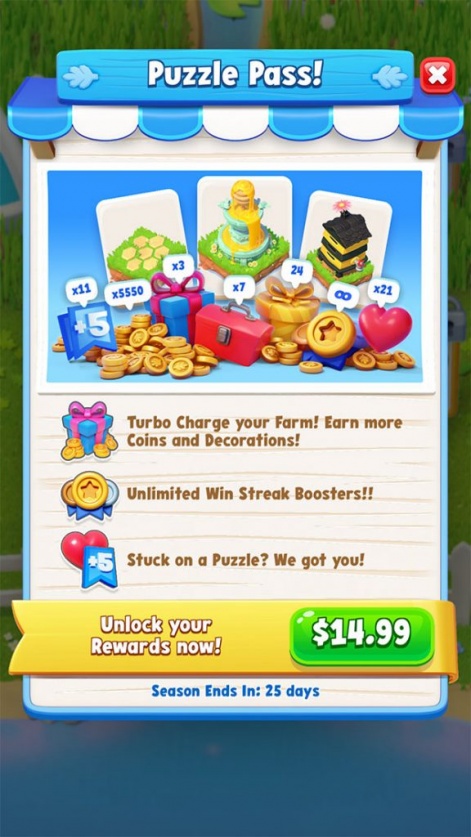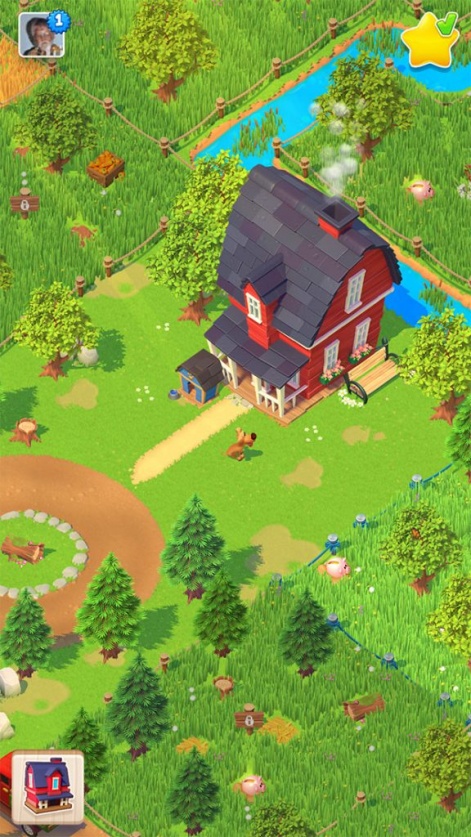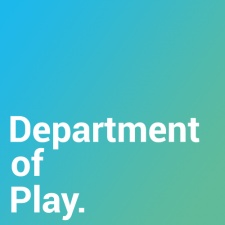Welcome to PG.Biz Deep Dives, where we invite industry experts to go under the hood of key industry trends or deconstruct top games and share their insight. Today we have a deep dive into Supercell’s Hay Day Pop, brought to you by Department of Play founding consultant Will Luton.
This article first appeared on the Department of Play blog.
What Is It?
Supercell, the studio behind Clash of Clans and Clash Royale, are revisiting their first breakout hit, Hay Day. However, where Hay Day was a farming sim in the style of Farmville, Hay Day Pop is a match-3 with city builder elements, much like the Gardenscapes games.
Launch Date: 16 March 2020
Status: Soft Launch (New Zealand, Australia and Finland)
Genre: Puzzle / City Builder
Similar to: Gardenscapes, Toy Blast, Hay Day and Candy Crush Saga
Why is it important?
Supercell are one of the few mobile studios who have been able to recreate success across multiple products and genres (Hay Day, Clash of Clans, Clash Royale, Brawl Stars and Boom Beach). They are known for successful innovation and great production values, so when a game of theirs appears, there’s always something interesting to learn.
This is only the second time Supercell have ventured in to the highly competitive match market, the first being Spooky Pop which was canned in soft launch. Can they succeed in what is one of the most difficult yet lucrative genres on mobile?
How Does It Play?
The core gameplay is match-3 in the style of the Blast series from Peak Games: Tap on groups of blocks to destroy them, get booster blocks for certain matches. New mechanical gimmicks and level goals (e.g. Grow X Carrots) are introduced as the levels progress. This core gameplay will be very familiar to many.
It’s within the metagame where things get really interesting. The player is gaining along several different progression vectors:
- Areas & Farm Points: The player’s farm is broken down into several areas, which can be unlocked sequentially once the player reaches a requisite number of Farm Points, which are gained from buying and placing items in the farm. Later players can also purchase and place functional items, such as livestock, which generate resources on timers.
- Star River & Puzzle Pass: As the player collects stars from playing match puzzles, they progress through levels in the Star River. Although presented somewhat like a saga map, Star River is functionally the same as a battle pass: There are free rewards per level, but also additional rewards offered to those who have purchased the Puzzle Pass.
- Win Streaks: As players complete puzzle levels they get progressively more bonuses to take into the level, including extra Stars, but a streak is lost if they fail a level and lose a life. This is very similar to Toon Blast’s Crown Rush mechanic and encourages players to engage in loss aversion mechanics (see Move Tokens).
How Does the Economy Work?
The core game mechanic has five key currencies:
- Coins: Soft currency which is earned by chopping down trees or otherwise found in farm areas. Coins are used to buy farm decorations (e.g. benches) and functional items (e.g. tomato patches or chicken coops).
- Diamonds: Hard currency that can be used to purchase Hearts, Move Tokens, Tool Boxes and Boosters.
- Hearts: Lost when a puzzle level is failed. When at zero, the player is unable to play a level. Hearts are regained over time, but also gained from Star River.
- Stars: Gained up to 3 per puzzle level, with a bonus extra for those at full Win Streak. Used to progress the Star River.
- Farm Points: This can be considered much like XP as at certain milestones, the farm level increases. Each new level unlocks a new Area and corresponding farm items. Farm Points are gained from placing items in the farm.
In addition there several items that also make up the game’s complete itemisation:
- Boosters: These are perks that can be brought into a puzzle level, either automatically placed in the level at the start or used mid-game. They’re gained from functional farm items (e.g. livestock and crops), Win Streaks, Tool Boxes, and Star River.
- Move Tokens: These are used to gain extra moves once a player a player has failed a level. Unlike other games this is not a pure hard currency purchase and has been added to the itemisation, making the reward diversity much richer.
- Tool Boxes: A gacha that features purely Boosters.
Within the balance, the Star River is driving much of the progression as the major source of coins. Coins purchase farm items, granting Farm Points and unlocking new areas. Therefore there’s a lot of pressure for players to purchase that season’s Puzzle Pass to continue progressing optimally, otherwise they’ll receive only a fraction of the coins available. And much like other battle pass style systems, these premium rewards accumulate uncollected, making the incentive to purchase ever greater.
What is good?
Solid Core Gameplay
Surprisingly for a company that’s relatively new to the match genre, the puzzle design and balancing is rather solid. This is harder than it seems, as match studios have spent years building their tech stack and refining level design to put players on the knife-edge of win-loss that drives loss aversion behavior. Supercell have clearly studied up or hired match expertise, because the match gameplay and level design feels as good as the best.
Durable Progression Battle Pass
The team have also taken a big bet on putting a battle pass system (Puzzle Pass), which is historically used for cosmetic unlocks, right in the middle of their durable progression. While in the first few hours this seems to work (especially as the first season is free), the key to long term success will be in balancing the benefits of the Puzzle Pass: Too generous or too stingy and pacing for paying and non-paying players could feel wonky.

This is the first time in recent years an F2P game has given such a clear pay gate on progression – generally this is more obfuscated through timers and complex game economies. However, Hay Day Pop is being pretty clear: You’ll simply get more coins as you progress if you pay for a subscription.
It’s a bold strategy, but it feels like it works. There are enough sinks that players racing ahead with the Puzzle Pass can spend their coins, while there’s enough coins for non-subscribers to still feel like they’re moving forward.
However, one risk remains: That the Puzzle Pass becomes the single spend point for the vast majority of players ultimately limiting the top end spend. I’m sure this is something that Supercell’s analysts will be watching very closely.
Building Choice
Unlike some of Hay Day Pop’s peers (Homescapes, Gardenscapes, Matchington Mansion etc), which have a rather linear and non-consequential set of building choices, Hay Day Pop is very close to being a full-fledged city builder game: Players can choose various options which in turn have at least the illusion of impacting the game’s economy, although most functional farm items are count-limited by area unlocks.
This gives the game a greater sense of non-linearity and depth but also offers the player creativity in their layout. In fact, area progression is directly linked to the count of items in your farm, and with functional farm items in short supply players are forced to place cosmetic items. This means even progression-hungry players are likely to slow down and consider shrubbery placement.
Production Values
While Hay Day Pop is in soft launch, the production quality is, as expected for Supercell, above that of what most studios could ever hope to achieve. In comparison to Supercell’s last game to make it out of soft launch, Brawl Stars, Hay Day Pop feels much more refined for this point in the release cycle. This might be indicative of the company’s faith in the product, but more likely in the need to compete in a match-3 market full of very competent and mature products.
Additionally, the team is also benefitting from working from a known style and set of characters, meaning the art team hit the ground running.
What could be better?
Samey Core Gameplay
Hay Day Pop’s biggest strength is also its biggest weakness: The blast-style matching gameplay is now over five years old (Toy Blast launched January 2015) and while Supercell have emulated it very well, it feels rather stale. This is likely to lead to early churn for lots of players coming from other match-3s, many of which have hit market saturation several years ago.
Meanwhile, there are games that try novel approaches in the match and puzzle space, such as the physics-based mechanics of Angry Birds Dream Blast.
It’s very clear that the team behind this weren’t making a bet on the core gameplay, but instead on the metagame. Which may seem like a smart risk mitigation move, but potentially increases the risk profile of the game as it now loses a point of differentiation in the most crowded genre on mobile.
Social & Live-Ops
Players have interest in a game for a finite amount of time, but it’s in other humans that titles can unlock really long term retention. Therefore it’s surprising that Supercell, the masters of PvP and clan mechanics in mobile, have shipped this title with the lightest of social features.
The Neighbors mechanic gives you two faked friends, while granting Facebook permissions extends that to your entire social graph. However, the mechanic only allows you to view the other players’ farms and stats, with a single collectable star on one of the farms once per day. This is extremely light as a social featureset.

Even Toon Blast launched with a clan mechanic core to its experience, and while the mechanics were minimal (chat and heart gifting), it made the game feel much more alive. And that sense is sorely missing from Hay Day Pop right now.
A clan mechanic which would allow players to gift or trade resources with other members, perhaps allowing for set completing or crafting, would give the game a great deal more longevity. Something essential in the LTV war of match-3.
The game is additionally missing any kind of live-ops, such as events, which is not unexpected in a game in soft launch, but will need to be added as the product matures.
Narrative
One of the key features of Hay Day Pop’s peers (Homescapes, Gardenscapes, Matchington Mansion etc) is their use of a clear through narrative, which sets them apart from most F2P mobile games. While this can be intrusive for players who aren’t story-motivated, it’s something no doubt genre veterans will be looking for.
While I don’t think talking heads are essential for Hay Day Pop’s success, it would be possible to integrate more of a sense of story and intrigue into the world via non-intrusive means, such as story collectables and the in-world dialogue. Otherwise Supercell are ignoring an entire player psychographic, albeit one they don’t traditionally serve.
Will It Leave Soft Launch?
Hay Day Pop is undeniably a well executed, solid game. It has a lot of charm, it’s evidently been well planned and there’s been lots thoughtful playability and UX testing. Any studio would be over the moon to have produced it. But Supercell aren’t any studio, and they have a notoriously high bar for taking games out of soft launch, killing titles that would likely be profitable but not top 50 grossing.
Hay Day Pop’s gameplay is the least unique game of any of Supercell’s worldwide launched games (Boom Beach notwithstanding), yet it has one standout proposition: It’s a Hay Day game.
Hay Day was one of the most successful mobile titles of all time with over 340 million downloads. It was once considered a “feeder app” to Clash of Clans as user acquisition was so much cheaper that part of Supercell’s strategy was to fill Hay Day and cross promote to Clash where there was a higher LTV. This means that there is a ready-made audience that loves the Hay Day brand. UA managers therefore can run super effective retargeting and lookalike campaigns, which will bring eCPIs down to a point where they can be competitive in the match-3 red ocean.
Additionally, all of the concerns around lack of social and live-ops features can and will be resolved in time. Even the narrative concerns can be addressed rather easily via updates. But more importantly, despite the core similarity to other match titles, Hay Day Pop is really rather fun: It looks and feels wonderful. And the game economy looks robust, being well able to convert players, plus there’s enough itemisation to offer monetisation depth, despite the unknowns around the Puzzle Pass.
So, yes we expect that Hay Day Pop will proceed to global launch. And with the comparative maturity of the product, it would be unsurprising for it to go global in as few as a six months from now.
TL;DR
Hay Day Pop is, as you’d expect from a Supercell product: Very well executed. Surprisingly so for a team with little match-3 experience, but maybe not so when considering how cloned the core matching gameplay is.
It does take some risks by putting a battle pass monetisation path right in the middle of the metagame and adding lots of seeming depth in the builder aspects of the gameplay.
However, the title is massively lacking in social and live-ops features that will drive long term retention. Missing also are the narrative elements that builder-match hybrids are known for. The narrative element can be course corrected if needed and the social and live-ops features will undoubtedly come as the product matures.
Ultimately, it’s the Hay Day brand and existing audience that will give this game the edge in the UA battle ground, allowing the title to bring down eCPI to such a point that it can be profitable at scale.
Department of Play is the games’ industry’s first management consultancy. Founded in 2018, the agency has helped the likes of Facebook, Rovio and Jagex to grow games with expertise in product management, design, UA, art and engineering. Find out more about their products and services at https://departmentofplay.net/products-services/

